Bad Ems
Bad Ems (German: [baːt ɛms] (![]()
Bad Ems | |
|---|---|
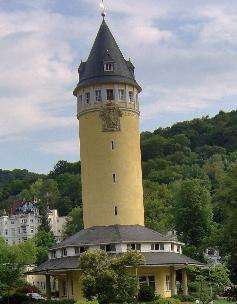 A Water tower built in Bad Ems in 1907 | |
 Coat of arms | |
Location of Bad Ems within Rhein-Lahn-Kreis district 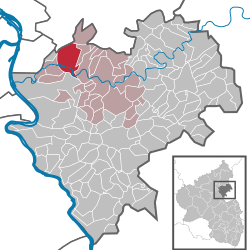 | |
 Bad Ems  Bad Ems | |
| Coordinates: 50°20′17″N 7°42′38″E | |
| Country | Germany |
| State | Rhineland-Palatinate |
| District | Rhein-Lahn-Kreis |
| Municipal assoc. | Bad Ems-Nassau |
| Government | |
| • Mayor | Oliver Krügel (CDU) |
| Area | |
| • Total | 15.36 km2 (5.93 sq mi) |
| Elevation | 80 m (260 ft) |
| Population (2018-12-31)[1] | |
| • Total | 9,681 |
| • Density | 630/km2 (1,600/sq mi) |
| Time zone | CET/CEST (UTC+1/+2) |
| Postal codes | 56130 |
| Dialling codes | 02603 |
| Vehicle registration | EMS |
| Website | www.bad-ems.de |
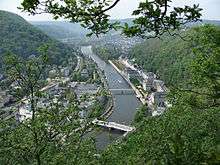
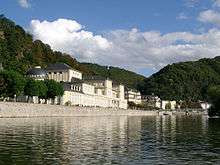
Geography
The town is located on both banks of the River Lahn, the natural border between the Taunus and the Westerwald, two parts of the Rhenish Slate Mountains. The town and its outer districts are situated within the Nassau Nature Reserve.
History
In Roman times, a castrum was built at Bad Ems as part of the Upper Germanic Limes, but today not much of the structure remains. In the woods around the town, however, there are distinct traces of the former Roman border.
The town was first mentioned in official documents in 880 and received its town charter in 1324. The Counts of Nassau and Katzenelnbogen rebuilt the bath and used it together with other noble visitors.[2] In the 17th and 18th centuries Bad Ems was considered one of Germany's most famous bathing resorts. It reached its heyday in the 19th century when it welcomed visitors from all over the world and became the summer residence of various European monarchs and artists, including Kaiser Wilhelm I of Germany, Tsars Nicholas I and Alexander II of Russia, Richard Wagner, Fyodor Dostoevsky and Vasili Vasilyevich Vereshchagin, etc.
In 1870, the town, then part of Prussian Hesse-Nassau, became known as the place where the Ems Dispatch originated, instigating the Franco-Prussian War.
In 1876, in the Haus Vier Türme (Four Tower House), the Ems Edict was signed by Alexander II of Russia, banning the use of the Ukrainian language. Today, a monument at the spot commemorates this historical event.
Mining
In the 19th and 20th centuries a lot of mining for metal ores took place in the town, concentrated on lead, silver, zinc and copper. The Romans had already dug for ores using open cast mining, which continued throughout the Middle Ages. The many indentations on Blöskopf Hill bear witness to this period of history. As time went by, the method changed from open cast mining to underground mining with tunnels and shafts. Mining of this kind is first mentioned in a document dated 1158, and it continued on into the 18th century, although with long interruptions.
The advent of the Industrial Revolution led to the expansion of the mine, which from 1871 operated under the name of Emser Blei- und Silberwerk AG (Bad Ems Lead and Silver Works, Inc.). In 1909 the company was taken over by what later became the Stolberger Zink AG (Stolberg Zinc Inc.) and mining continued until the end of the Second World War brought things to a halt in 1945. After the war, the mine no longer received any subsidies, but until 1959, stockpiled ore and ore from other mines were sorted at the central preparation plant in Silberau.
Today, the mine is still known as "Mercur", the collective name for various individual pits. Since 1996, the mine has been set up as a museum.
Economy
Industry in Bad Ems is mainly limited to companies related to its spa status, but nonetheless fairly varied, including medicine, electrical engineering and tourism.
Mineral springs
Natural Ems salt is produced from local mineral water. The spring's mineral water, noted for its very high mineral content, is also marketed separately for drinking and inhalation purposes; when inhaled using a vaporizer, the water has a beneficial effect on sore throats.[3]
Infrastructure
Transport
The town is linked to a view point at the Bismarckturm (Bismarck tower) by the Kurwaldbahn funicular railway. Bad Ems station lies on the Lahn Valley Railway.
Governance
Mayor
The mayor of Bad Ems is Bernard Abt (SPD).
Town twinning
Bad Ems is twinned with:
Notable people
Sons and daughters of the town
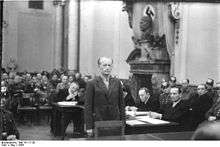
- 1888: Max Jacob, puppeteer and founder of the Hohnsteiner Puppenbühne
- 1898: Adolf Reichwein, German educator, economist and cultural politicians, resistance fighter during the Third Reich, died 1944
Personalities who are associated with the city
- 1811: Joseph Derenbourg, orientalist, died 1895
- 1819: Jacques Offenbach, composer, last stay in Bad Ems, many operettas listed here, died 1880
- 1841: John Naish, Lord Chancellor of Ireland, died in Bad Ems while taking a cure in 1890 and is buried there
- 1944: Botho Strauss, writer and playwright, born in Naumburg, schooling through high school in Bad Ems
- 1952: Thomas C. Breuer, writer and comedian, born in Eisenach, schooling in Bad Ems
- 1974: Josef Winkler, born in Koblenz, former member of parliament (Alliance 90/The Greens)
Notes
- "Bevölkerungsstand 2018 - Gemeindeebene". Statistisches Landesamt Rheinland-Pfalz (in German). 2019.
- "Katzenelnbogener Weltrekorde: Erster RIESLING und erste BRATWURST!". www.graf-von-katzenelnbogen.de.
- "Emser Kränchen Tafelwasser - Informationen". emser-kraenchen-tafelwasser.de.
References
- Stella Ghervas, « Spas' political virtues : Capodistria at Ems (1826) », Analecta Histórico Médica, IV, 2006 (with A. Franceschetti).
- Much of the content of this article comes from the equivalent German-language Wikipedia article (retrieved September 5, 2005).
External links
![]()
- Historical footage of Bad Ems, 1914, filmportal.de